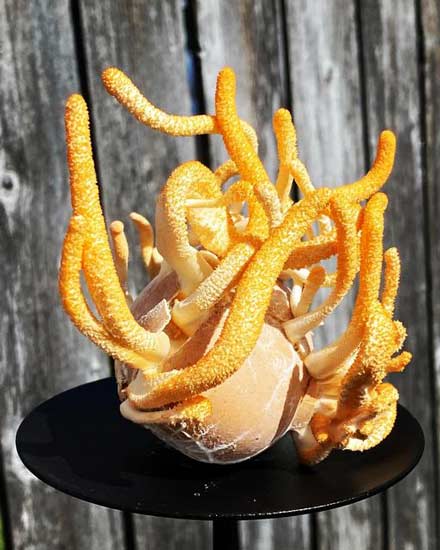Cordyceps Militaris ‘mushrooms’

Cordyceps militaris
Cordyceps is a type of edible fungus (all mushrooms are fungus) with several hundred different strains which occur naturally, mostly in Asia. They’re undoubtedly one of the most unusual organisms you’ll ever come across. Many TV viewers might already know that one strain, (Cordyceps Sinensis) was the basis of the parasitic fungus which featured in HBO’s series ‘The Last of Us’ and is sometimes called the ‘zombie ant fungus’ because it infects and grows on ants and other insects and pupae!
Cordyceps Militaris is the strain that you and I can grow at home and there’s no danger of it turning your family into zombies, no matter how many you give your mother-in-law! They’re not ‘mushrooms’ in the normal sense but are close relatives.
Old Chinese medical books and Tibetan medicine describe Cordyceps as a treasure and traditional healers use it as a powerful tonic to improve energy, appetite, stamina, and endurance. Highly valued for their natural ability to fight free radicals, infections and inflammation, cordyceps have been used for centuries to reduce symptoms of respiratory disorders, coughs, colds, liver damage and much more.
Cordyceps Militaris can be grown at home whereas Cordyceps sinensis (the most expensive ‘mushroom’ in the world costs around $20,000 per kg) can’t. This wild species exists only in the Himalayan mountains in Tibetan grows on ghost moth larva. Cordyceps militaris is commercially grown in labs using mycelial extracts innoculated into grain, wood or other substances.
For the sake of convenience in writing we’ll call cordyceps militaris a mushroom from this point, even though it’s more accurately described as a relative of ‘normal’ mushrooms.
Medical Benefits
The cordyceps militaris mushroom is an incredible energy-boosting fungi. Studies studies have found that cordyceps improves exercise performance in healthy older individuals.
Cordyceps mushrooms were used in Traditional Chinese Medicine at least 5,000 years ago. Their medicinal uses and benefits were described in old Chinese medical books, and holistic healers have been using them to cure dozens of diseases for generations. Along with other medical plants, Cordyceps Chinese, Christian and Hindu religious ceremonies and are said to be linked to longevity and immortality.
It’s believed that the many anti-inflammatory benefits of cordyceps come from their ability to affect our immune systems, fighting oxidative stress and stimulating protective cells that keep the body free from infections. In-vitro studies suggest that cordyceps can act like natural cancer treatments in some cases, preventing the growth of tumors and cancer cells. Considered a type of natural “immuno-potentiating drug,” cordyceps supplements are often used to enhance immunity and optimize health.

Cordyceps growing from an egg
Growing Cordyceps
Cordyceps militaris is well known for being a tricky fungus to cultivate. This isn’t hard to understand when you consider the cordyceps species have selective and strange food choices in the wild, which notoriously include caterpillars, ants and other insects. It’s worth noting that the substrates used for other mushroom types just won’t work for cordyceps.
Many non-insect substrates have been tested out including beans, lentils, quinoa, eggs and rice. Based on many reports and testing, rice generally provides the most abundant yields. White or brown rice are economical choices.
Of those growers we’ve spoken to, none have claimed 100% success using any particular method and many have experienced fully-colonised substrates that never fruit. Others have successfully cultivated Cordyceps using variations on an egg-based media. Temperature control is very important, and failures in that respect may account for many of the failed crops.
We haven’t personally cultivated cordyceps, largely because our normal clients don’t ask us for them, so we don’t have any cultivation methods we’d recommend based on experience. We will however be publishing an article for home mushroom growers which will outline a range of techniques and materials we have gathered over time, and which have been claimed to work well. That article will follow in due course and when it is available can be found by clicking this link: Growing Cordyceps at home.
